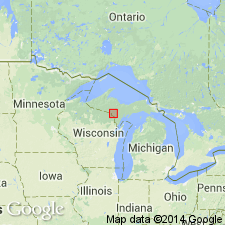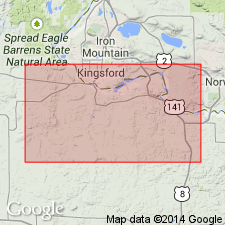
- Usage in publication:
-
- Hoskin Lake Granite*
- Modifications:
-
- Geochronologic dating
- AAPG geologic province:
-
- Lake Superior region
Summary:
Isotopic dating of minerals from sample no 26, pink granite, SE1/4, SE1/4 sec 8, T38N, R20E, Marinette Co, WI. Biotite: K-Ar 1,220 m.y.; Rb-Sr 1,350 m.y. Muscovite: K-Ar l,350 m.y.; Rb-Sr 1,500 m.y. K-Feldspar: K-Ar 1,070 m.y.; Rb-Sr 1,530 m.y. Zircon: Th232-Pb208 1,050; U238-Pb206 840; U235-Pb207 1,120; Pb207-Pb206 1,720 m.y. Diffusion age: U-Pb 2,130 m.y. Demonstrates variable resistance to post-formation thermal events shown by various minerals and decay systems tested. Assigned to Middle Precambrian.
Source: GNU records (USGS DDS-6; Denver GNULEX).

- Usage in publication:
-
- Hoskin Lake Granite*
- Modifications:
-
- Named
- Dominant lithology:
-
- Granite
- AAPG geologic province:
-
- Lake Superior region
Summary:
Named for Hoskin Lake which lies in NE1/4 sec 23, T38N, R19E, Florence Co, WI in the Lake Superior region. Good exposures found in S1/2 sec 12 and N1/2 sec 13, T38N, R19E, and NE1/4 sec 17, T38N, R20E. No type locality specifically designated. Consists of coarse-grained and porphyritic granite with large subhedral, white, gray or flesh-colored, microcline phenocrysts as long as 2 1/2 in set in a matrix of partially sericitized oligoclase, quartz microcline, and biotite. Chlorite and hornblende occur with the biotite; epidote is a sparse alteration product of oligoclase. Zircon, apatite, and subhedral to euhedral sphene, locally altered to leucoxene, are ubiquitous accessory minerals. Generally, half the granite consists of microcline phenocrysts. The granite does grade into non-porphyritic coarse-grained quartz monzonite. Intrudes the Marinette Quartz Diorite (new) and metabasalts of the Quinnesec Formation. Age not known with certainty. Age relation to Animikie is uncertain. Precambrian age.
Source: GNU records (USGS DDS-6; Denver GNULEX).
For more information, please contact Nancy Stamm, Geologic Names Committee Secretary.
Asterisk (*) indicates published by U.S. Geological Survey authors.
"No current usage" (†) implies that a name has been abandoned or has fallen into disuse. Former usage and, if known, replacement name given in parentheses ( ).
Slash (/) indicates name conflicts with nomenclatural guidelines (CSN, 1933; ACSN, 1961, 1970; NACSN, 1983, 2005, 2021). May be explained within brackets ([ ]).

